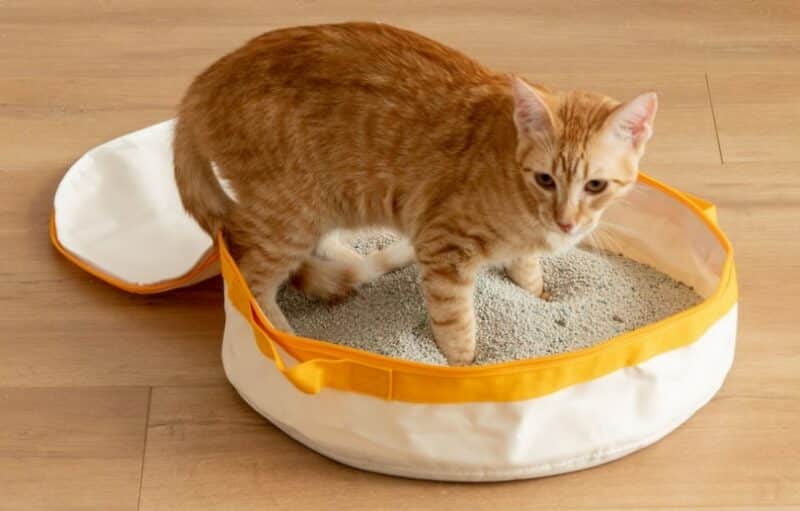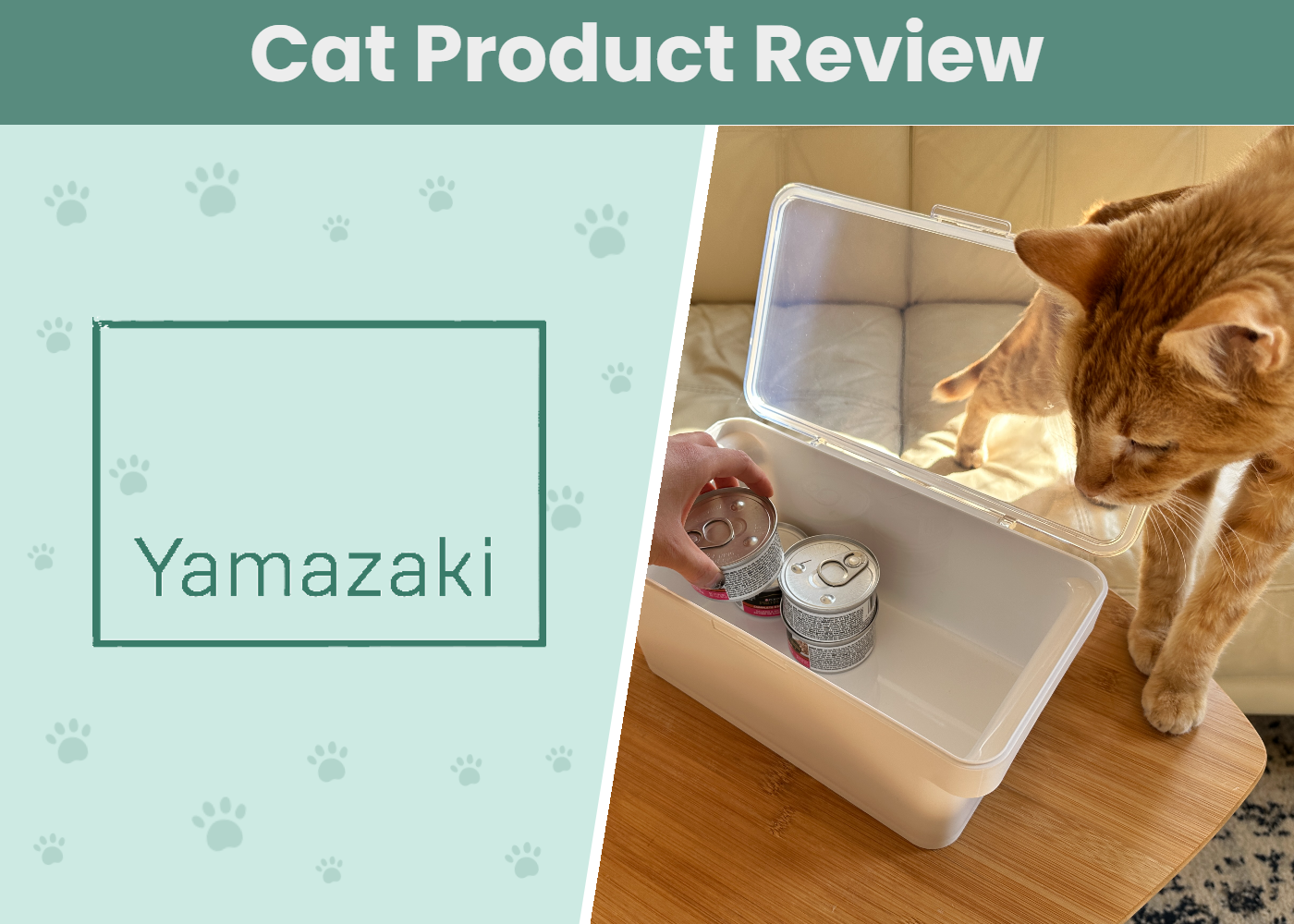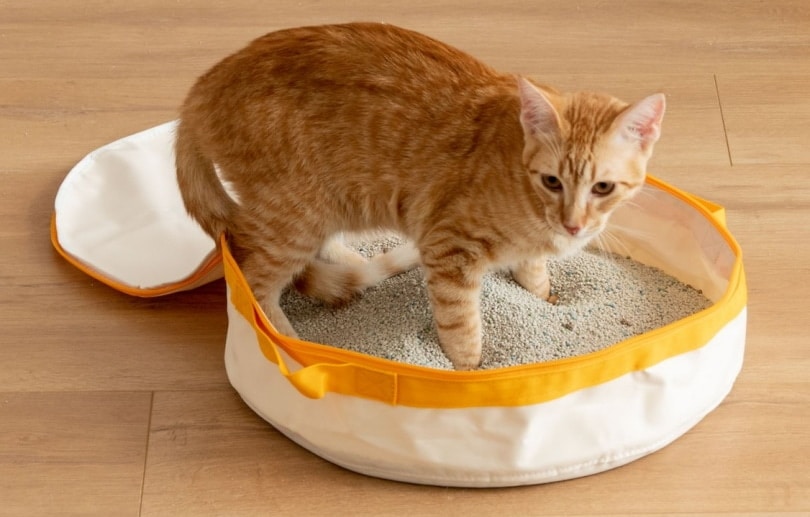
Many cat owners want to travel with their cats because they don’t want to be away from them for any length of time. Some cats are agreeable to it and enjoy getting out and seeing new things. Other cats might not like being left alone for long periods, and bringing them along is better for everyone.
Whatever reason you choose for taking your cat along with you on your next trip, you’ll have to pack their supplies. This seems easy enough — until you remember that they will need a litter box!
Travel litter boxes are easy to transport without having to clean, empty, and haul the one that is regularly in your home. Our reviews of travel litter boxes are here so you can choose the best one to suit your needs. Traveling with your furry buddy can be easier than you might think!
A Quick Comparison of Our Favorites – Top Picks 2024
| Image | Product | Details | ||
|---|---|---|---|---|
| Best Overall |

|
Pet Fit Litter Collapsible Box |
|
CHECK PRICE |
| Best Value |

|
Kitty’s WonderBox Disposable |
|
CHECK PRICE |
| Premium Choice |

|
Petleader Collapsible Box |
|
CHECK PRICE |
| Best for Kittens |
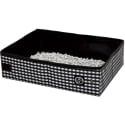
|
Necoichi Portable Box |
|
CHECK PRICE |

|
Petisfam Portable Box |
|
CHECK PRICE |
The 10 Best Travel Litter Boxes
1. Pet Fit For Life Collapsible Portable Litter Box — Best Overall

| Dimensions | 15”L x 11”W x 5”H |
| Material | Canvas |
The Pet Fit For Life Collapsible Portable Litter Box comes with a bonus collapsible water bowl for even more convenience. The nylon fabric enables this litter box to be folded up easily and stored flat, saving room in your luggage. It is ideal for use in an RV or on camping trips. The box holds 5 pounds of litter and is waterproof to prevent leaks. When the litter is empty, clean it by wiping the inner poly-plastic coating with a soapy cloth and dry it. Fold it back up and you’re ready to travel again. If your cat digs aggressively in the litter box, they may be able to claw the plastic bottom of this one and scratch it. This typically isn’t a big issue, though, because the box is only used temporarily.
- Waterproof
- Collapsible
- Easy to clean
- Bottom liner may be scratched by claws
2. Kitty’s WonderBox Disposable Litter Box — Best Value
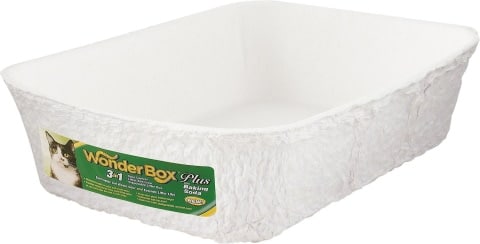
| Dimensions | 17”L x 13.5”W x 4”H |
| Material | Recycled paper |
Our value choice for a travel litter box is the Kitty’s WonderBox Disposable Litter Box. It is ideal for use when you don’t want to have to deal with cleaning out a litter box repeatedly and toting it along with you. The durable material is 100% leakproof. Each box can be used for one month before it needs to be replaced. The box is claw-proof and compatible with any brand of litter that you choose. When you’re done using it, simply throw it away. No cleanup is required with this product. It’s made from recycled paper and is biodegradable. The material enables air to filter through the box, keeping the litter dry and odor-free. The box may be too small for large cats. There are a few reports of the material changing and becoming less absorbent than it was in the past. Still, this is our best choice for the money when you need a travel litter box option.
- Leakproof
- Biodegradable
- Lasts for 1 month of use
- No cleanup required
- Material changed
- May be too small for large cats
3. Petleader Collapsible Litter Box — Premium Choice
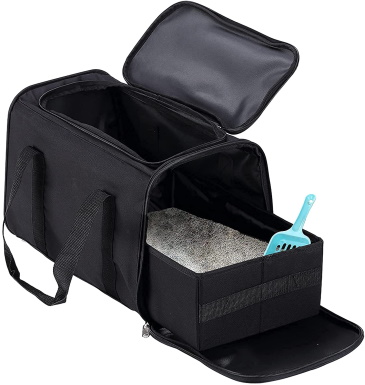
| Dimensions | 17.7”L x 11”W x 11”H |
| Material | Oxford |
This portable Petleader Collapsible Litter Box makes transport easy by keeping everything contained in a convenient bag. There are no litter spills to worry about when the bag is sealed. When you get to your destination, open the top of the bag for your cat to enter and exit. When it’s time to scoop, open the side door and pull the litter box out for easy access. The bag has pockets for scoops, waste bags, and other cat supplies. The Oxford material and PVC lining make the bag leakproof. The inner surface of the box is flat and easy to wipe clean. This durable bag can support up to 30 pounds of litter and supplies.
Large cats may have trouble using the litter pan if it’s left in the bag. In this case, pulling it out and using the bag only to transport the box is recommended.
- Zipped bag holds 30 pounds of litter and supplies
- Easily scoopable
- No leaks or spills
- Large cats may not fit inside the bag
4. Necoichi Portable Litter Box — Best for Kittens
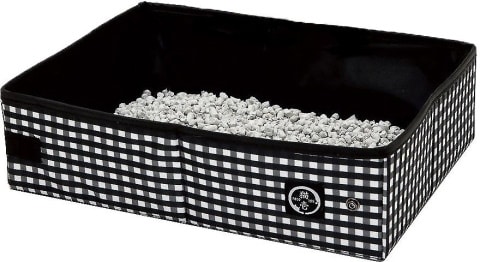
| Dimensions | 15”L x 11”W x 5.1”H |
| Material | Polyurethane |
The Necoichi Portable Litter Box folds down and snaps shut, making it easy to transport and store when not in use. The inner lining is waterproof and can be cleaned by hand with a damp cloth. This box can be used in the car while you’re traveling, making it a suitable option for kittens that may need potty breaks along the way. The material is resistant to claws and won’t be damaged by a scratching cat. This box can easily hold 2–3 inches of litter.
There are reports of the sides not staying open all the way unless the box is filled with litter.
- Snaps shut for easy storage
- Waterproof
- Durable design
- Sides cave in if the box is empty
- No pockets for holding supplies
5. Petisfam Portable Litter Box
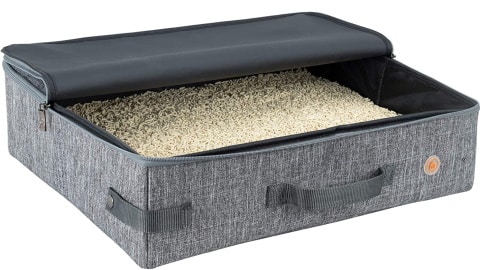
| Dimensions | 19.7”L x 15.8”W x 5.1”H |
| Material | Vinyl |
The entire Petisfam Portable Litter Box is made from heavy-duty vinyl that is easy to wipe clean. It’s reusable and durable enough to withstand long, multiple trips. When it’s zipped closed, it looks like a small suitcase but only weighs 1.7 pounds when empty. This zipping feature also traps leaks, odors, and litter scatter. If not used as a litter box, it can be a way to transport your cat’s belongings or be used as a bed for them during travel. The box fits well in small spaces and comes with a scoop and a collapsible food/water bowl for added convenience. As for the litter, this box can hold about the same amount as a standard litter box in your home, so your cat can feel more comfortable using it. When not in use, this litter box folds all the way down to the size of a wallet, making storage easy.
There are a few reports of the box being difficult to fold into its compact form.
- Zips closed to prevent spills
- Leakproof
- Easy to clean
- Can be difficult to refold
- Litter may leak if the zipper isn’t completely zipped
6. PetSafe Disposable Collapsible Litter Box

| Dimensions | 16”L x 12”W x 14.38”H |
| Material | Cardboard, silicone |
The PetSafe Disposable Collapsible Litter Box is flat until you’re ready to use it. Then it pops up into a covered litter box to give your cat privacy while traveling. If your cat is already accustomed to a covered litter box, this is a convenient option for them. The box comes with a bag of PetSafe Crystal Litter. You can use this or any other litter you like. It also comes with eight disposable scoops so you don’t have to worry about cleaning or losing your own scoops while traveling. The wax coating on the inside of the box stops leaks. Each box can be used for up to a week before it should be replaced.
- Disposable scoops
- Covered for privacy
- Disposable box
- Scoops may be too weak for large clumps
7. Iris Travel Litter Pan

| Dimensions | 15.5”L x 15.5”W x 3.94”H |
| Material | Canvas |
The lightweight Iris Travel Litter Pan is an easy way to set up a potty for your kitty anywhere you go. It can be used in RVs, campers, hotel rooms, and cars. The foldable canvas material has a zipper closure that captures litter and spills. It’s covered in PVC coating to prevent leaks. The top of this pan unzips fully to give your cat access to the entire litter area. When not in use, it’s easy to store just by cleaning it with soap and water, letting it dry, and folding it up until next time. When fully zipped, this pan can be transported with litter inside of it. The walls may be too low to contain large cats.
- Zipper closure
- Leakproof
- Easy to clean
- Price
- Low walls
8. Nature’s Miracle Disposable Cat Litter Box
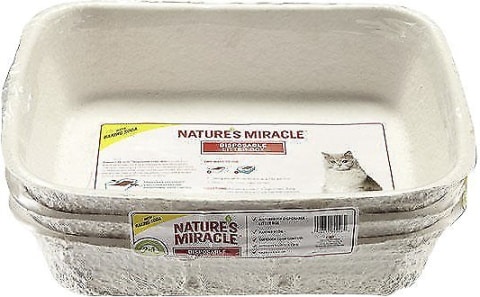
| Dimensions | 20.75”L x 14.5”W x 6.75”H |
| Material | Recycled paper |
The Nature’s Miracle Disposable Cat Litter Box comes in regular and jumbo sizes so you can choose the right one for your cat. Each box is made with baking soda to eliminate odors. There are two boxes in the jumbo pack and three boxes in the regular pack, making it a good value for longer trips where you’ll need to change the boxes. When one is soiled, simply throw it away and use a fresh one. The boxes are biodegradable and made of recycled materials, so there is no worry about harming the environment.
- Disposable
- Biodegradable
- Made with baking soda to fight odors
- Boxes are large
- Boxes don’t collapse for easy transport
9. ZenKitty Biodegradable Litter Box
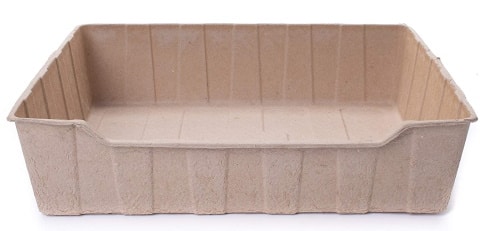
| Dimensions | 17”L x 13”W x 5”H |
| Material | Recycled paper |
The ZenKitty Biodegradable Litter Box comes in a four-pack, so you will have extras if you’re going on a long trip. These trays are lightweight and biodegradable so you can throw them away when they’re dirty. In addition to being used while traveling, these pans can also be used as liners for your litter box at home to aid in cleanup. When it’s time for a complete refresh, you can throw the pan away and not have to scrub the outer litter box. These leakproof trays can also be used in an emergency, such as severe weather warnings. There are reports of people keeping these trays on hand during tornado warnings so their cat has a ready-to-use litter box in the basement or bathroom.
- Biodegradable
- Leakproof
- Convenient
- The trays don’t collapse or fold up
- Bulky to transport
10. Convelife Collapsible Litter Box
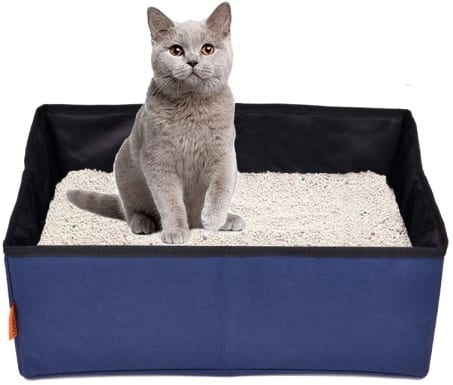
| Dimensions | 16”L x 11.5”W x 6”H |
| Material | Nylon |
The nylon material of the Convelife Collapsible Litter Box is completely waterproof, so you don’t have to worry about leaks. This box is foldable and easy to transport or store when not in use. You can wipe the inside of the box clean by hand or put the entire thing in the washing machine, making it convenient to clean. It’s also lightweight and deep enough to hold litter without it scattering everywhere. The box is large enough to hold most cats, but it may be too small for some. There are reports of this box being kept on hand for emergencies, along with a supply of litter.
- Collapsible
- Easy to clean
- Waterproof
- May be too small for large cats
Buyer’s Guide: Selecting the Best Travel Litter Box
The good news about traveling with cats is that most of them get used to new routines quickly. This is helpful, especially since using a litter box is something that comes instinctively to cats. You won’t have to spend time trying to train your cat to use one in a new environment. That said, there are still a few things to consider when choosing a travel litter box for your cat, so you can make your traveling as smooth as possible.
Litter Box Size
Most travel litter boxes are smaller than the regular litter box that you use at home. If you think a travel box might not be the right size for your cat but you don’t know for sure, you can have them try it out at home before you start traveling. Cats may not like to use a box that they feel is too small.
The litter box also needs to be transported easily and efficiently. Most travel litter boxes are either disposable or collapsible, making them easy to travel with and set up. They also don’t take up too much room in the luggage areas.
If you’re traveling by car, the travel litter box could fit into the cat’s carrier with them, making it safe for them to use it without having to open their carrier.
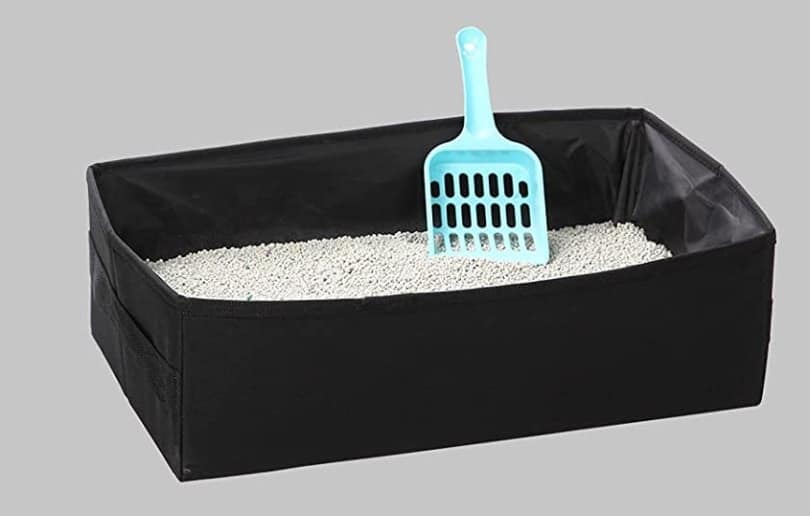
Litter Boxes in the Car
It can seem cruel to leave your cat in a carrier during a long car trip, but it’s the safest way to transport them. If you have the space, you might be tempted to leave them out with free access to their litter box whenever they need it. Being loose in the car can be dangerous for your cat. If you need to brake quickly, the cat could get injured. If you get into an accident, the cat could flee the scene and get lost in unfamiliar territory. Your cat could even distract you by jumping on you while you’re driving, creating a dangerous situation. If you need to stop for gas and open your door, the cat could jump out and run.
It’s best to find a litter box that fits into the travel carrier and that will give your cat enough room to use it whenever the need should arise. If you’d like your cat to get out and stretch their legs, make sure their harness and leash are attached before you open any car doors.
Litter Box Durability
It’s important to make sure that the box you select doesn’t fall apart when you need it most. The material should be sturdy and made of canvas, nylon, or vinyl for reusable boxes. The zippers should stay securely closed. The entire box should be able to be cleaned, either by hand or in a washing machine. Water-resistance and leakproof materials should be chosen whether the box is disposable or not.
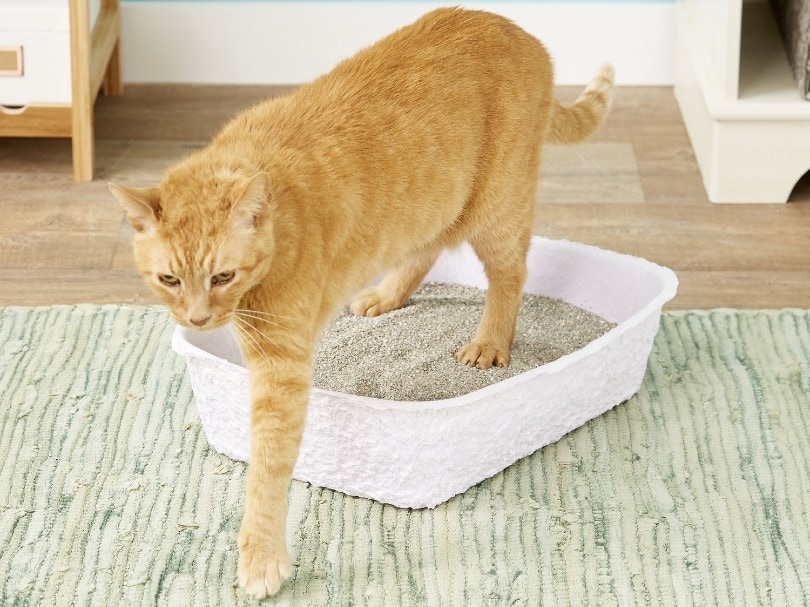
Litter for Travel Boxes
You can use the same litter that you always do. It’s what your cat knows and likes. Some travel litter boxes come with their own litter. It’s a matter of your personal preference to use it. If you’d like to use the same litter that you have at home, you certainly can. Travel litter boxes don’t require special litter.
Which One Is the Best Travel Litter Box?
Disposable Travel Litter Box
Disposable litter boxes are popular choices because they are convenient. At the end of their use, you just throw the whole thing in the trash. For car trips, RV trips, etc., disposable boxes work well. You can easily use them in hotel rooms when you get to your destination. The problem is that they might be too big to fit into your cat’s travel carrier.
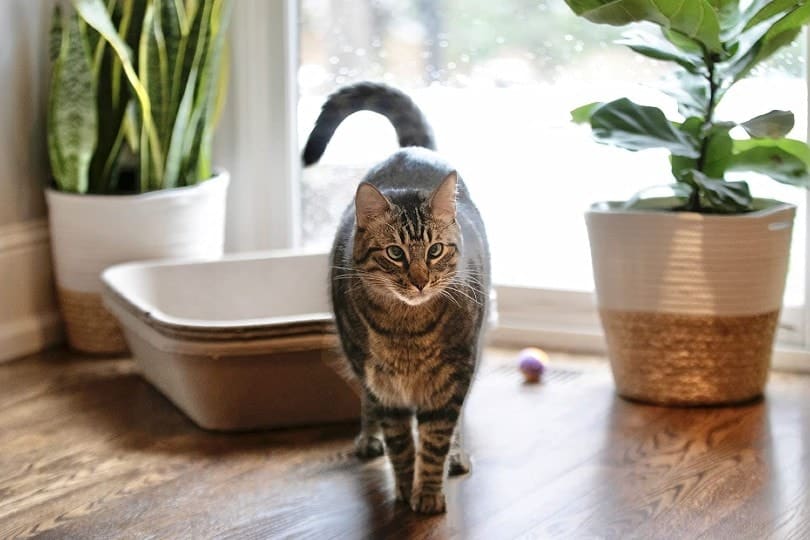
Reusable Travel Litter Box
Reusable travel litter boxes should be used if you’re flying because they can easily fold up and be tucked away in your carry-on bag. Reusable boxes are also a popular choice if you travel frequently by car and don’t want to continue investing in disposable boxes. Reusable litter boxes are waterproof, so you can spot-clean as necessary while traveling. Disposable boxes, once soiled, need to be discarded.
Is a Travel Litter Box Really Necessary?
If you’re traveling with your cat for a roundtrip that is less than 8 hours long, they probably won’t need a litter box and can wait until they get home. Anything longer than that, though, you’ll want to at least be able to give them the option of using a litter box. Whether they will depends on how comfortable they are. The stress of traveling can sometimes be too much for your cat. They may not eat or drink, so they won’t have an urgent need to use a litter box. Cats sometimes hold their bladders if they’re feeling uncertain about things. Once you arrive back home or at your travel destination, your cat should go back to their regular routine.
Whether you’re moving states, taking an extended vacation, or simply want to bring your cat with you on your adventures, a travel litter box is essential.
Conclusion: Best Travel Litter Box
The best travel litter box for you will be one that is similar to what your cat is already used to. Things to consider are the distance that you’re traveling and the method in which you’re traveling.
Our overall best choice is the Pet Fit For Life Collapsible Portable Litter Box. We like that it holds plenty of litter and folds up flat for storage. Our best value choice is Kitty’s WonderBox Disposable Litter Box. It’s disposable, leakproof, and biodegradable. We hope that our reviews gave you a few options to try for your next adventure with your feline companion.
Featured Image Credit: IRIS, Chewy
Contents
- A Quick Comparison of Our Favorites – Top Picks 2024
- The 10 Best Travel Litter Boxes
- 1. Pet Fit For Life Collapsible Portable Litter Box — Best Overall
- 2. Kitty’s WonderBox Disposable Litter Box — Best Value
- 3. Petleader Collapsible Litter Box — Premium Choice
- 4. Necoichi Portable Litter Box — Best for Kittens
- 5. Petisfam Portable Litter Box
- 6. PetSafe Disposable Collapsible Litter Box
- 7. Iris Travel Litter Pan
- 8. Nature’s Miracle Disposable Cat Litter Box
- 9. ZenKitty Biodegradable Litter Box
- 10. Convelife Collapsible Litter Box
- Buyer’s Guide: Selecting the Best Travel Litter Box
- Which One Is the Best Travel Litter Box?
- Is a Travel Litter Box Really Necessary?
- Conclusion: Best Travel Litter Box


